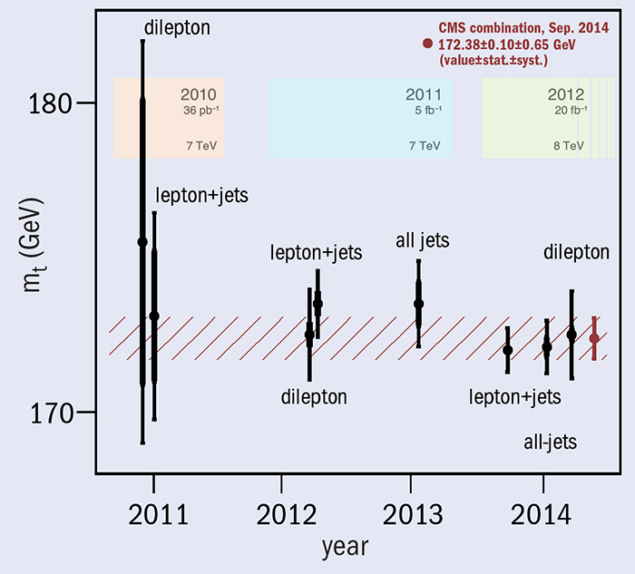Precise measurements of the mass of the top quark provide key inputs to global electroweak fits and to tests of the internal consistency of the Standard Model. The masses of the Higgs boson and the top quark are the two key parameters that determine whether the vacuum is stable – an issue with broad cosmological implications.

At the LHC, top quarks are predominantly produced in quark–antiquark pairs, and top-quark events are characterized by the decays of the daughter W bosons and bottom quarks, leading to three experimental signatures. In the “lepton+jets” channel, the two bottom-quark jets are accompanied by a single lepton (e or μ) and one undetected neutrino from the decay of one of the W bosons, together with two light-quark jets from the other W. In the dilepton channel, both W bosons decay to leptons, so two leptons (ee, eμ, μμ) and two undetected neutrinos accompany the bottom-quark jets. Last, if the W bosons both decay to quark–antiquark pairs, the signature will include four light-quark jets – the all-jets channel.
At the recent TOP2014 workshop in Cannes, the CMS collaboration presented a new measurement of the mass of the top quark, based on the full LHC data set recorded during 2012. This corresponds to approximately 20 fb–1 of integrated luminosity at √s = 8 TeV, which is roughly four times the size of the combined data sets at √s = 7 TeV from 2010 and 2011. The latest result comes from a new measurement in the dilepton channel (CMS Collaboration 2014a). It complements the results from the lepton+jets and all-jets channels that were announced earlier this year (CMS Collaboration 2014b and 2014c).
The new measurement uses an analytical matrix-weighting technique to determine the most probable solution for missing transverse energy in the events. The top-quark mass is determined from a fit to the combined results, yielding a value of 172.47±0.17 (stat.) ±1.40 (syst.) GeV. In contrast, for the other two analyses, two-dimensional likelihood functions were used to determine simultaneously the top-quark mass and the overall jet-energy scale. The measurements of 172.04±0.11 (stat.) ±0.74 (syst.) GeV and 172.08±0.27 (stat.) ±0.84 (syst.) GeV, together with the new result, complete the initial set of high-precision analyses using the Run 1 data.
At the TOP2014 workshop, CMS also presented a combination of these results with five previous measurements using the 2010 and 2011 data sets (CMS Collaboration 2014d). The figure shows the combination and the evolution of the CMS measurements as a function of time. The combined value for the top-quark mass is found to be 172.38±0.10 (stat.) ±0.65 (syst.) GeV. With a precision of 0.38%, this is the most precise result from any single experiment. Work continues on additional analyses using alternative techniques, and results from these are expected in the coming months.
Further reading
CMS Collaboration 2014a CMS-PAS-TOP-14-010.
CMS Collaboration 2014b CMS-PAS-TOP-14-001.
CMS Collaboration 2014c CMS-PAS-TOP-14-002.
CMS Collaboration 2014d CMS-PAS-TOP-14-015.








